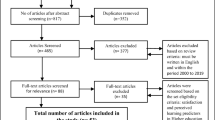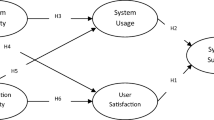Abstract
E-learning systems, assessed through computers and/or mobile devices, are widely adopted to assist university students’ learning. Nonetheless, the impact of surprise in the design of e-learning systems still needs clarification. The link of learners’ multiple goals orientation to their e-learning system use behavior also lacks clarification. This study, therefore, clarifies the issues based on the updated IS success model. Data of two hundred and forty-one university learners who used e-learning systems in their course learning were gathered and analyzed with SEM. The results validated the significant association of surprise with university students’ system use and user satisfaction that facilitated the transfer of the learning to their overall learning outcome. However, learners of different learning goals orientation presented different patterns of learning transfer through e-learning systems. The results reflected different roles of e-learning to learners of different learning goals orientation in their learning adaptation.




Similar content being viewed by others
References
Ames, C. (1992). Classrooms: Goal, structures, and student motivation. Journal of Educational Psychology, 84(3), 261–271. https://doi.org/10.1086/461536.
Bagozzi, R. P., & Yi, Y. (1988). On the evaluation of structural equation models. Journal of the Academy of Marketing Science, 16(1), 74–94. https://doi.org/10.1007/BF02723327.
Bereiter, C. (1995). A dispositional view of transfer. In A. McKeough, J. Lupart, & A. Marini (Eds.), Teaching for transfer: Fostering generalization in learning (Vol. 47, pp. 21–34). Mahwah: Lawrence Erlbaum. https://doi.org/10.1080/00461520.2012.693354.
Berlyne, D. E. (1971). Aesthetics and psychobiology. Appleton-Century-Crofts.
Boekaerts, M., de Koning, E., & Vedder, P. (2006). Goal-directed behavior and contextual factors in the classroom: An innovative approach to the study of multiple goals. Educational Psychologist, 41(1), 33–51. https://doi.org/10.1207/s15326985ep4101_5.
Borokhovski, E., Bernard, R. M., Schmid, R. F., & Sokolovskaya, A. (2016). Technology-supported student interaction in post-secondary education: A meta-analysis of designed versus contextual treatments. Computers & Education, 96(May), 15–28. https://doi.org/10.1016/j.compedu.2015.11.004.
Browne, M. W., & Cudeck, R. (1993). Alternative ways of assessing model fit. In K. A. Bollen & J. S. Long (Eds.), Testing structural equation models (pp. 445–455). Newbury Park: Sage.
Burns, J., Clift, J., & Duncan, J. (1990). Understanding of understanding: Implications for learning and teaching. British Journal of Educational Psychology, 61, 276–289. https://doi.org/10.1111/j.2044-8279.1991.tb00985.x.
Chen, H. J., & Kao, C. H. (2012). Empirical validation of the importance of employees’ learning motivation for workplace e-learning in Taiwanese organisations. Australasian Journal of Educational Technology, 28(4), 580–598 http://www.ascilite.org.au/ajet/ajet28/chen-hj.html.
Chin W. W. (1998). The Partial Least Squares Approach to Structural Equation Modeling. In: G. A. Marcoulides (Ed.), Modern Methods for Business Research (pp. 295–336). New Jersey: Lawrence Erlbaum Associates Publisher..
Covington, M. V., & Müeller, K. J. (2001). Intrinsic versus extrinsic motivation: An approach/avoidance reformulation. Educational Psychology Review, 13, 157–176.
DeLone, W. H., & McLean, E. R. (1992). Information systems success: The quest for the dependent variable. Information Systems Research, 3(1), 60–95. https://doi.org/10.1287/isre.3.1.60.
DeLone, W. H., & McLean, E. R. (2003). Model of information system success: A ten-year update. Journal of Management Information Systems, 19(4), 9–30. https://doi.org/10.1080/07421222.2003.
DeLone, W. H., & McLean, E. R. (2004). Measuring e-commerce success: Applying the DeLone & McLean information systems success model. International Journal of Electronic Commerce, 9(1), 31–47. https://doi.org/10.1145/332833.332845.
Dweck, C. S. (1986). Motivational processes affecting learning. American Psychologist, 41(10), 1040–1048. https://doi.org/10.1037/0003-066X.41.10.1040.
Dweck, C. S., & Leggett, E. L. (1988). A social-cognitive approach to motivation and personality. Psychological Review, 95, 256–273.
Elliot, A. J. (1997). Integrating the “classic” and “contemporary” approaches to achievement motivation: A hierarchical model of approach and avoidance achievement motivation. In M. L. Maehr & P. R. Pintrich (Eds.), Advances in motivation and achievement (Vol. 10, pp. 143–179). Greenwich: JAI Press. https://doi.org/10.1037/h0043445.
Elliot, A. J., & Church, M. (1997). A hierarchical model of approach and avoidance achievement motivation. Journal of Personality and Social Psychology, 72, 218–232. https://doi.org/10.1007/s11031-006-9028-.
Elliot, A. J., & Covington, M. V. (2001). Approach and avoidance motivation. Educational Psychology Review, 13, 73–92.
Elliot, A. J., & Thrash, T. M. (2002). Approach-avoidance motivation in personality: Approach and avoidance temperaments and goals. Journal of Personality and Social Psychology, 82(5), 804–818. https://doi.org/10.1037/0022-3514.82.5.804.
Fornell, C., & Larcker, D. F. (1981). Structural equation models with unobservable variables and measurement errors. Journal of Marketing Research, 18(1), 39–50. https://doi.org/10.2307/3151312.
Giovannangeli, C., & Gaussier, P. (2008). Autonomous vision-based navigation: Goal-orientated planning by transient states prediction, cognitive map building, and sensory-motor learning. Proceedings of the International Conference on Intelligent Robots and Systems, Nice, France. https://doi.org/10.1109/IROS.2008.4650872.
Goodfellow, R. & Lea, M. (2007). Challenging E-learning in the university: A literacies perspective. Society for Research into Higher Education, Open University Press. McGraw Hill, Maidenhead & New York. http://oro.open.ac.uk/id/eprint/8410
Gray, W. D., & Orasanu, J. (1987). Transfer of learning: Contemporary research and applications. In S. Cormier & J. Hagman (Eds.), Transfer of training (pp. 183–215). San Diego: Academic Press.
Hair, J. F., Money, A. H., Samouel, P., & Babin, B. (2006). Essentials of business research. Wiley.
Harackiewicz, J. M., Barron, K. E., & Elliot, A. J. (1998). Rethinking achievement goals: When are they adaptive for college students and why? Educational Psychologist, 33, 1–21.
Harden, R. M. (2007). Outcome-based education: The future is today. Medical Teacher, 29, 625–629. https://doi.org/10.1080/01421590701729930.
Harter, S. (1981). A new self-report scale of intrinsic versus extrinsic orientation in the classroom: Motivational and informational components. Developmental Psychology, 17, 300–312. https://doi.org/10.1037/0012-1649.17.3.300.
Hirschman, E. C., & Holbrook, M. B. (1982). Hedonic consumption: Emerging concepts, methods and propositions. Journal of Marketing, 46(3), 92–101.
Holmberg, B. (1983). Guided didactic conversation in distance education. In D. Sewart, D. Keegan, & B. Holmberg (Eds.), Distance education: International perspectives (pp. 114–122). London: Croom Helm.
Hong, J.-C., Taia, K.-H., Kuo, Y.-C., & Chen, J.-S. (2017). Internet cognitive failure relevant to users' satisfaction with content and interface design to reflect continuance intention to use a government e-learning system. Computers in Human Behavior, 66(January), 353–362. https://doi.org/10.1016/j.chb.2016.08.044.
Karabenick, S. A. (1998). Strategic help seeking: Implications for learning and teaching. Mahwah: Erlbaum. https://doi.org/10.1108/lm.1999.20.5.5.3.
Kerlinger, F. N., & Lee, H. B. (2000). Foundations of behavioral research (4th ed.). Wadsworth.
Komiak, S. Y. X., & Benbasat, I. (2006). The effects of personalization and familiarity on trust and adoption of recommendation agents. MIS Quarterly, 30(4), 941–960. https://doi.org/10.1287/mnsc.46.4.563.12061.
Kraft, R. J., & Sakofs, M. (Eds.). (1985). The theory of experiential education. Boulder: Association for Experiential Education. Chicago.
Kulkarni, U. R., Ravindran, S., & Freeze, R. (2006). A knowledge management success model: Theoretical development and empirical validation. Journal of Management Information Systems, 23(3), 309–347. https://doi.org/10.2753/MIS0742-1222230311.
Löwgren, J. (2007). Fluency as an experiential quality in augmented spaces. International Journal of Design, 1(3), 1–10.
Maehr, N. L., & Midgley, C. (1991). Enhancing student motivation: A school-wide approach. Educational Psychologist, 26, 399–427. https://doi.org/10.1207/s15326985ep2603&4_9.
McLuhan, R, (2000). Go live with a big brand experience, Marketing, Oct. 26.
Midgley, C., & Urdan, T. (2001). Academic self-handicapping and achievement goals: A further examination. Contemporary Educational Psychology, 26, 61–75. https://doi.org/10.1006/ceps.2000.1041.
Midgley, C., Maehr, M. L., Hruda, L., Anderman, E. M., Anderman, L., Freeman, K. E., Gheen, M., Kaplan, A., Kumar, R., Middleton, M. J., Nelson, J., Roeser, R., & Urdan, T. (2000). Manual for the patterns of adaptive learning scales (PALS). Ann Arbor: University of Michigan.
Nova, Y. L. & Ramim, M. M. (2017). The e-learning skills gap study: Initial results of skills desired for persistence and success in online engineering and computing courses. Proceedings of the 12th Chais Conference for the Study of Innovation and Learning Technologies: Learning in the Technological Era, pp. 57E-68E.
Peng, S. L., & Cherng, B. L. (2005). The relationship among a 4-dimensional classroom goal structure, personal goal orientation and academic help-seeking behavior. Journal of Research in Education Sciences (in Chinese), 50(2). https://doi.org/10.3966/2073753X2005105002005.
Pine II, B., & Gilmore, J. (2013). The experience economy: Past, present and future. In J. Sundbo & F. Sørensen (Eds.), Handbook on the experience economy (p. 269). Edward Elgar. https://doi.org/10.4337/9781781004227.00007.
Pintrich, P. R. (1999). Taking control of research on volitional control: Challenges for future theory and research. Learning and Individual Differences, 1, 335–335. https://doi.org/10.1016/S1041-6080(99)80007-7.
Pintrich, P. R. (2000a). Multiple goals, multiple pathways: The role of goal orientation in learning and achievement. Journal of Educational Psychology, 92, 544–555. https://doi.org/10.1037/0022-0663.92.3.544.
Pintrich, P. R. (2000b). The role of goal orientation in self-regulated learning. In M. Boekaerts & P. R. Pintrinch (Eds.), Handbook of self-regulation (pp. 13–39). San Diego: Academic Press. https://doi.org/10.1016/B978-012109890-2/50043-3.
Pintrich, P. R., & Schunk, D. (1996). Motivation in education: Theory, research & applications, Ch. 3. Englewood cliffs: Prentice-hall.
Rai, A., Lang, S. S., & Welker, R. B. (2002). Assessing the validity of IS success models: An empirical test and theoretical analysis. Information Systems Research, 13(1), 50–69. https://doi.org/10.1287/isre.13.1.50.96.
Schmitt, B. H. (1999). Experiential marketing. New York: The Free Press.
Seddon, P. B., & Kiew, M. Y. (1996). A partial test and development of DeLone and Mclean’s model of IS success. Australian Journal of Information Systems, 4(1), 90–109. https://doi.org/10.3127/ajis.v4i1.379.
Shore, L. M., & Thornton III, G. C. (1986). Effects of gender on self and sapervisory ratings. Academy of Management Journal, 29, 115–129. https://doi.org/10.2307/255863.
Steenkamp, J. E. M., & Van Trijp, H. C. M. (1991). The use of LISREL in validating marketing constructs. International Journal of Research in Marketing, 8(4), 283–299. https://doi.org/10.1016/0167-8116(91)90027-5.
Su, C. H., Tzeng, G.-H., & Hu, S.-K. (2016). Cloud e-learning service strategies for improving e-learning innovation performance in a fuzzy environment by using a new hybrid fuzzy multiple attribute decision-making model. Interactive Learning Environments, 24(8), 1–24. https://doi.org/10.1080/10494820.2015.1057742.
Sun, P.-C., Tsai, R. J., Finger, G., Chen, Y.-Y., & Yeh, D. (2008). What drives a successful e-learning? An empirical investigation of the critical factors influencing learner satisfaction. Computers & Education, 50(4), 1183–1202. https://doi.org/10.1016/j.compedu.2006.11.007.
Teng, D. C.-E., Chen, N.-S., & Kinshuk, L. T. (2012). Exploring students’ learning experience in an international online research seminar in the Synchronous Cyber Classroom. Computers & Education, 58(3), 918–930. https://doi.org/10.1016/j.compedu.2011.10.018.
Vansteenkiste, M., Timmermans, T., Lens, W., Soenens, B., & Van den Broeck, A. (2008). Does extrinsic goal framing enhance extrinsic goal-oriented individuals’ learning and performance? An experimental test of the match perspective versus self-determination theory. Journal of Educational Psychology, 100(2), 387–397. https://doi.org/10.1037/0022-0663.100.2.387.
Wirth, J., Künsting, J., & Leutner, D. (2009). The impact of goal specificity and goal type on learning outcome and cognitive load. Computers in Human Behavior, 25(2), 299–305. https://doi.org/10.1016/j.chb.2008.12.004.
Wu, J.-H., & Wang, Y.-M. (2006). Measuring KMS success: A respecification of the DeLone and McLean’s model. Information & Management, 43(6), 728–739. https://doi.org/10.1016/j.im.2006.05.002.
Ziegler, A., & Heller, K. A. (2000). Approach and avoidance motivation as predicators of achievement behavior in physics instructions among mildly and highly gifted eight-grade students. Journal for the Education of the Gifted, 23(4), 343–359. https://doi.org/10.1177/016235320002300402.
Author information
Authors and Affiliations
Corresponding author
Ethics declarations
Conflict of interest
The author declares no conflict of interest.
Additional information
Publisher’s note
Springer Nature remains neutral with regard to jurisdictional claims in published maps and institutional affiliations.
Rights and permissions
About this article
Cite this article
Chen, HJ. Clarifying the impact of surprise in e-learning system design based on university students with multiple learning goals orientation. Educ Inf Technol 25, 5873–5892 (2020). https://doi.org/10.1007/s10639-020-10249-6
Received:
Accepted:
Published:
Issue Date:
DOI: https://doi.org/10.1007/s10639-020-10249-6




